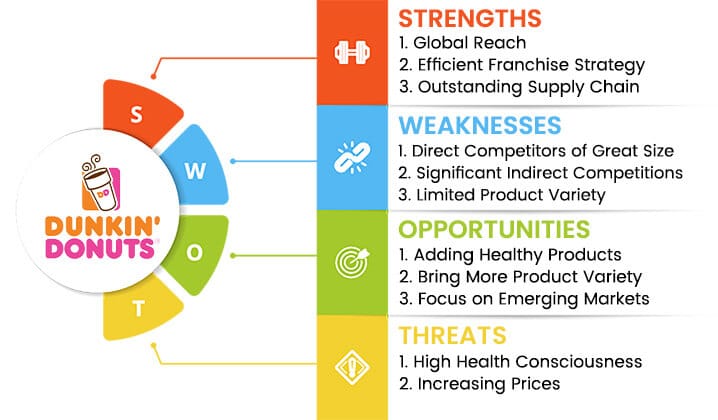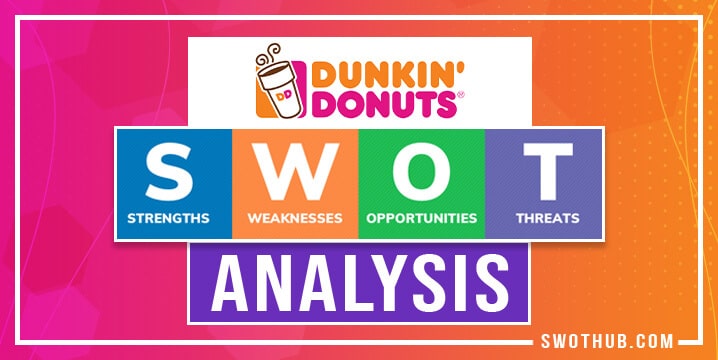Whether you are craving coffee or donuts, Dunkin Donuts has been serving the delicious duo for over 75 years. A Dunkin Donuts SWOT analysis will highlight its strengths and weaknesses, and we’ll see Dunkin Donuts’ competitors.
In 1948, a new shop opened, named “Open Kettle.” The shop sold donuts for five cents and coffee for ten cents. Things were going well, but the founder, William Rosenberg, thought of a change. A new name came to him after a deep conversation with his executives. The name was Dunkin Donuts. It was 1950 when Dunkin Donuts was founded, and they continue to serve delicious coffee and donuts around the world to this day. In today’s article, we will analyze Dunkin Donuts SWOT Analysis to gain more insight into the way they operate.
Table of Contents
Dunkin Donuts SWOT Analysis: At A Glance
| Company Name | Dunkin’ Donuts |
| Industry | Food and beverage |
| Founded | 1950 |
| Founders | William Rosenberg |
| CEO | David Hoffmann |
| Headquarter | Canton, Massachusetts, U.S. |
| Annual Revenue | $1.370 Billion (FY 2019) |
| Website | www.dunkindonuts.com |
Dunkin Donuts SWOT Analysis
A SWOT analysis is essential to understanding a company’s internal and external factors. SWOT analysis comprises external factors (opportunities and threats) and internal factors (strengths and weaknesses). Through SWOT analysis, Dunkin Donuts can better understand, determine their chances, and take them. Furthermore, a Dunkin Donuts SWOT analysis can help identify risks help us understand the dynamics of the company, and identify Dunkin Donuts competitors in comparison.
Dunkin Donuts SWOT Analysis Strengths

Also known as the core competencies, strengths consist of strong factors. These factors make the company stand out from its competitors. Here are the strengths of Dunkin Donuts SWOT analysis.
Global Reach: Dunkin Donuts is a worldwide brand, and they sell their product in several countries. Starting with a shop in 1950, the brand now has over 11,300 restaurants worldwide. We can find Dunkin Donuts in 36 countries, where more than 3,200 restaurants are available.
Despite Dunkin Donuts’ global reach, the company focuses heavily on the US market. As a result, two-thirds of their total restaurants are located only in the US. Currently, 8,500 restaurants are located in the US.
Efficient Franchise Strategy: Dunkin Donuts’ success story heavily relies on its franchise strategy. Different than other franchising companies, Dunkin Donuts has a set of four rules for a franchise. The rules are:
- Significant demand for the product in the market
- Experience with the food industry
- Dedication for business
- Adequate resources
Outstanding Supply Chain: Bakery products don’t last long. However, bakery products are what Dunkin Donuts sells. Therefore, they need to ensure a perfect logistic system that will keep them as fresh as baked. Because Dunkin Donuts has such a great supply chain, they can do it daily.
Dunkin Donuts will ensure that the products arrive at the seller’s doorstep on time, day or night. The system was made possible by changing the business model and upgrading the transportation system.
Weaknesses of Dunkin Donuts in SWOT Analysis

In contrast to strengths, weaknesses are the things that need to be improved. A company needs to increase its efforts in this area since it lags behind the competition. Dunkin Donuts SWOT analysis has the following weaknesses.
Direct Competitors of Great Size: There is no doubt that Dunkin Donuts is a huge company. However, their direct competitors are not small either. Synonymous with coffee, the Instagram favorite Starbucks is competing against. Besides, Krispy Kreme and Costa Coffee are available and doing good in the market.
In 2020, according to Statista, Starbucks had over 15,000 coffee shops in the US. Dunkin Donuts sits second with over 9000 coffee shops, significantly lower than Starbucks. In comparison to Starbucks, there is no question that Dunkin Donuts lacks a significant market share.
Significant Indirect Competitions: It’s not always direct competition that one needs to be aware of, not always direct competition. Sometimes, indirect competition can strongly impact one company’s performance and market share. In terms of Dunkin Donuts’ indirect competition, the situation is again quite volatile. Major food chains like Pizza Hut, McDonald’s, and KFC can take away Dunkin’ Donuts customers, even though they don’t sell the same product.
Limited Product Variety: Another weakness of Dunkin Donuts is they don’t sell products in different strategies. Yes, their products are extremely tasty. But if one is looking for something new to try, maybe they are not the ones to try.
Dunkin Donuts SWOT Analysis Opportunities

Opportunities are external factors that allow a company to achieve a competitive advantage. They can greatly influence the company’s future performance. Dunkin Donuts SWOT analysis reveals the following opportunities.
Adding Healthy Products: More and more people are becoming health conscious. Research shows that 65% of customers are looking for nutritional benefits in the food they consume. The stat indicates that Dunkin Donuts will attract more consumers by bringing healthy food options to the menus. In addition, Dunkin Donuts can do branding differently along the way, similar to a healthy-conscious brand.
Bring More Product Variety: A big issue with Dunkin Donuts is that they have a limited amount of products available. Although the quality and the taste of their products are great, the consumers do want more from them. For example, there are six options to choose from in the sandwich section in the current menu from Dunkin Donuts. Dunkin Donuts can increase this menu with newer additions of sandwiches.
Focus on Emerging Markets: Even though Dunkin Donuts operates in 36 countries, most shops are in the US. The US is a big country with a huge customer base, but expanding to other countries offers a huge potential for greater consumer reach. Additionally, this will even play as a competitive advantage compared to the brand’s direct competition. For example, Starbucks operates in 80 countries. Dunkin Donuts will have a competitive edge if they manage to run in more than 80 countries, or perhaps in countries where Starbucks does not operate.
Dunkin Donuts SWOT Analysis Threats

A threat is an element of the external environment that can damage a business. Neglecting these can negatively impact the future performance of a business. The following is a discussion of Dunkin Donuts’ SWOT analysis threats.
High Health Consciousness: Opportunities can be a threat, a clear example. Dunkin Donuts will likely lose customers if they do not offer more healthy options on their menu. The chances of losing customers will increase if competitors provide such products.
Increasing Prices: As the costs of the products are getting higher day by day, the company can be forced to increase the prices of the products. The situation can be quite challenging for consumers to buy their products. Therefore, Dunkin Donuts needs to find ways to cut their cost low to keep its prices stable and low.
Who are Dunkin Donuts competitors in SWOT Analysis?
While you may be thinking of the delicious “hot-and-now” brand Krispy Kreme Donuts, the competitors may surprise you.
- Starbucks
- McDonald’s
- Tim Hortons
These companies are the top Dunkin Donuts competitors in a Dunkin Donuts SWOT analysis.
Compared to Starbucks, McDonald’s, and Tim Hortons, Dunkin Donuts has a competitive advantage in terms of convenience, accessibility, and price. Among the many goods and services that Dunkin Donuts provides are breakfast sandwiches, coffee drinks, donuts, and other portable snacks. In addition, Dunkin Donuts has a vast network of locations all over the United States and a strong online presence.
However, due to their larger size, stronger brand presence, and more established customer base, Starbucks, McDonald’s, and Tim Hortons pose a significant threat as Dunkin Donuts competitors.
Dunkin Donuts SWOT Analysis Overview Template

Dunkin Donuts SWOT Analysis Conclusion and Recommendations
These recommendations deduced from this Dunkin Donuts SWOT analysis from industry experts can help Dunkin Donuts improve its market game:
- Bring healthier options to the menu. The addition will allow health-conscious people to be customers of the brand and increase the variety in the menu of Dunkin Donuts.
- Never take indirect competitors lightly, as they can significantly impact the brand’s performance.
- Expand business overseas so that Dunkin Donuts can capture more consumer markets.
- Lower the operation and production costs to keep ever-rising prices stable.
Overall, we can say that Dunkin Donuts is still one of the biggest companies in the coffee and bakery industries. It is unlikely they will suffer losses any time soon due to their influence in this industry. Despite this, Dunkin Donuts should not be satisfied with its limited selection.
FAQs for SWOT Analysis of Dunkin Donuts
What is Dunkin Donuts’ competitive advantage?
Dunkin’s competitive edge lies in its quick service, cost-effective offerings, and adaptability to evolving consumer preferences.
What is Dunkin Donuts’ strengths?
Dunkin Donuts boasts a strong brand reputation, efficient franchise model, and diverse menu catering to local tastes. Its loyalty program also fosters customer retention.
What challenges does Dunkin Donuts face?
Dunkin faces fierce competition, fluctuating commodity prices, and the need to constantly innovate amidst changing consumer health trends.
A SWOT analysis is highly recommended for any company. Dunkin Donuts can consider internal and external factors in deciding which departments to enforce. Similarly, Dunkin Donuts SWOT analysis shows the company has vast strengths and opportunities, which can even help them gain a competitive advantage.






Pingback: Krispy Kreme SWOT Analysis 2022: A Delicious and Detailed Report! | SWOT Hub
Pingback: BUS 400 1-2 Blog: Project Analysis – Ariele SNHU